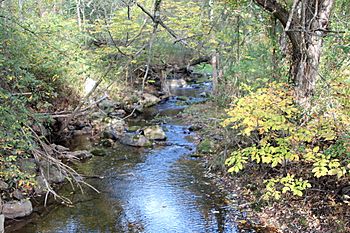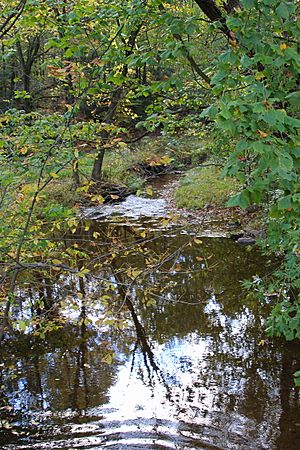Beaver Run (Catawissa Creek tributary) facts for kids
Quick facts for kids Beaver Run |
|
|---|---|
 |
|
| Physical characteristics | |
| Main source | valley in Beaver Township, Columbia County, Pennsylvaniavalley in Beaver Township, Columbia County, Pennsylvania 1,040 ft (320 m) |
| River mouth | Catawissa Creek in Beaver Township, Columbia County, Pennsylvania 649 ft (198 m) 40°57′08″N 76°18′33″W / 40.95212°N 76.30916°W |
| Length | 6.2 mi (10.0 km) |
| Basin features | |
| Progression | Catawissa Creek → Susquehanna River → Chesapeake Bay |
| Basin size | 9.60 sq mi (24.9 km2) |
Beaver Run is a small stream in Columbia County, Pennsylvania. It flows into Catawissa Creek. The stream is about 6.2 miles (10 kilometers) long. It runs through Beaver Township.
The area of land that drains into Beaver Run is 9.6 square miles (24.9 square kilometers). This area is called its watershed. The stream was named in 1774 by Alexander McCauley.
Contents
Where Does Beaver Run Flow?
Beaver Run starts in a valley in Beaver Township. This is close to the border of Columbia County and Luzerne County.
The stream first flows north for a short distance. Then it turns west. It flows west and slightly south for several miles. It runs between McCauley Mountain and Buck Mountain.
Later, it turns northwest and then southwest. A short distance downstream, it turns west again. It crosses Pennsylvania Route 339 before joining Catawissa Creek. Beaver Run meets Catawissa Creek about 13 miles (21 km) upstream from the creek's mouth.
Smaller Streams Joining Beaver Run
Beaver Run does not have any named smaller streams joining it. However, it does have two numbered tributaries. These are called Trib 27552 and Trib 27553.
Land and Rocks Around Beaver Run
The land near where Beaver Run joins Catawissa Creek is about 649 feet (198 meters) above sea level. Where the stream begins, it is higher, at about 1040 feet (317 meters) above sea level.
Beaver Run is a fairly slow-moving stream. In some places, it can be quite wide.
The land around Beaver Run is mostly made of a type of rock called the Mauch Chunk Formation. The soil in this area is known as Leck Kill soil.
The Beaver Run Watershed
The watershed of Beaver Run covers an area of 9.6 square miles (24.9 square kilometers). Most of this area is in Beaver Township, Columbia County. A small part of it reaches into Luzerne County.
The wetlands in the upper parts of the stream are very important. They are the largest and most diverse wetlands in Columbia County. This means they have many different kinds of plants and animals.
Much of the land in the Beaver Run watershed is used for agriculture. The stream flows through a narrow valley. This valley is located between Buck Mountain and McCauley Mountain.
The community of Shumans is located near where Beaver Run ends. Important roads in the watershed include Pennsylvania Route 339, Beaver Valley Road, and Mountain Shadow Lane.
History of Beaver Run
Beaver Run was likely named by Alexander McCauley in 1774. There's a story that he named it after watching a group of beavers building a dam on the stream. The nearby Beaver Township was also named after the stream.
In the late 1800s, a post office called Beaver Valley Post Office was located near the mouth of Beaver Run.
Two bridges have been built over Beaver Run that are longer than 20 feet (6 meters). The first was a concrete slab bridge built in 1930. It is 21 feet (6.4 meters) long. The second was a steel stringer bridge built in 1934. It is 29.9 feet (9.1 meters) long.
Plants and Animals of Beaver Run
The wetlands along Beaver Run are very special. They are listed as a "locally significant site" in the Columbia County Natural Areas Inventory. They are ranked highly for their importance.
These wetlands are a type of shrub swamp with highbush blueberry and meadowsweet plants. They also have trees and shrubs like red elderberry, black ash, poison sumac, speckled alder, buttonbush, steeple-bush, and mountain holly.
Other plants found here include different kinds of ferns and sedges. You can also find skunk cabbage, cattails, yellow pond lilies, smooth goldenrod, swamp candles, and woolgrass.
There are also other types of forests and swamps nearby. These include a red maple / yellow birch / eastern hemlock forest and another buttonbush / highbush blueberry shrub swamp. These areas have even more plant species.
Many different birds have been seen in the Beaver Run wetlands. These include the common yellowthroat, gray catbird, house wren, ovenbird, swamp sparrow, and yellow warbler. A type of dragonfly called the spangled skimmer also lives in these wetlands.
The Pennsylvania Department of Environmental Protection considers Beaver Run to be a coldwater fishery. This means it is a good place for fish that like cold water.


